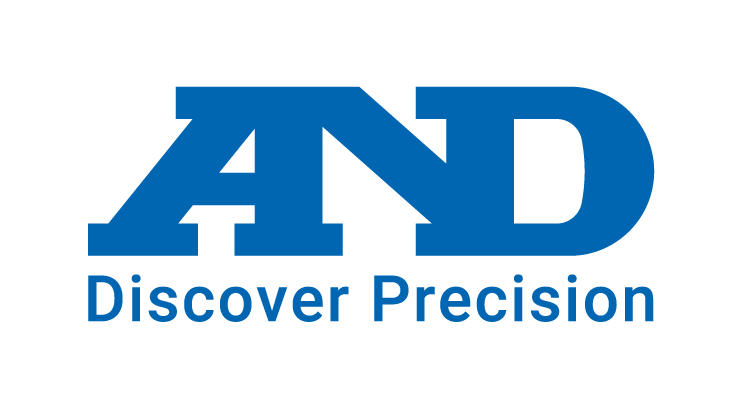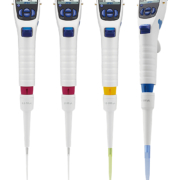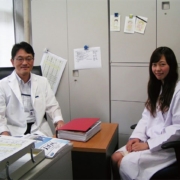Functionality and Performance of Electronic Pipettes
In spring this year, A&D launched our new MPA Series of original electronic single channel pipettes. With our exciting new products in hand, we visited research laboratories across Japan to explain their many benefits, starting in Kyushu’s Fukuoka, then moving to Shikoku Island, Osaka, Kyoto, Nagoya, the Hokuriku region, then finally areas in around Tokyo. Our promotional activities have already extended overseas as well, introducing the MPA Series to laboratories in Korea and conducting some market research there.
In this Development Story, I will summarize what we have learned from this market research and propose practical solutions to some of the problems that pipette users are facing in their place of work.
- Dispensing liquids with a high level of viscosity
If the viscosity of the dispensed liquid is high, it sticks to the outer perimeter and inner surface of the tip. Liquids that particularly pose a problem are those that stick to the inner wall of the tip. When this happens it is not possible to cleanly discharge or ensure accurate dispensing amounts. Addressing this problem requires, 1) slowing down the aspirating and dispensing speeds so the liquid can be properly transferred; 2) aspirating a larger amount of the liquid beforehand and establishing the dispensed amount based on the amount discharged (this is commonly called reverse mode and reduces the degree of error with the liquid that remains inside the tip); 3) using a tip with a wide circumference to reduce the pressure added to the high viscosity liquid. MPA electronic pipettes have five different speeds of aspiration and dispensing selectable and can be easily set to reverse mode, making more stable dispensing possible.
However, whichever of these methods is used, dispensing liquids with viscosities around 10 times higher than water (10 mPa•s) will always be a problem for micropipettes which rely on air pressure for their operation. A type of dispensing device that has a piston attach the liquid would have to be used for any viscosity level higher than this.
- Dispensing highly volatile liquids such as solvents
Many researchers feel that the dispensing of highly volatile and low viscosity liquids such as solvents is rather difficult. The cause of this problem is the empty space in the cylinder built into the pipette becoming filled with vapour from the solvent or other volatile liquid. In other words, as soon as the solvent is aspirated the piston is filled with vapour from the solvent, which increases pressure inside the cylinder and forces the solvent to leak out of the tip or makes the dispensing amount inconsistent. In order to avoid this phenomenon, it is recommended to aspirate and discharge the solvent several times before the dispensing is performed to create a constant vapour pressure. This so-called “pre-rinse” practice is recommended for not only solvents, but as an effective general preparation measure to ensure the accuracy of the dispensing process. One of the MPA Series’ many merits is simple switch-only operation of multiple aspiration-discharge actions which are effective for mixing liquids or performing pre-rinse.
- Operability when performing consecutive dispensing
Dispensing to a 96-well microplate is a difficult operation and even if a multiple channel pipette is used, a high degree of skill and dexterity is required to ensure correct dispensing amounts. When a manual single channel pipette is used for repeated dispensing, the same parallel movement of aspirating and dispensing is needed to be done many times, a frustrating task for the researcher and one which can consume a significant amount of time. With an electronic single channel pipette however, with one touch of the switch an amount equivalent to fill 8 or 12 wells can be aspirated in one go, then evenly dispensed with 8 or 12 touches. Particularly when very precise dispensing is required or when there is a need to reduce wasted use of an expensive solution, using an electronic single channel pipette, which provides easy operation and high accuracy, is shown to be the most effective measure.
- Consecutive dispensing with an electronic pipette
When multiple dispensing is performed with an electronic pipette, even amounts cannot be ensured and the first time can be a touch short. We also regularly hear that the final dispensed amount can also be insufficient among other complaints. These issues can also occur with manual-type pipettes in principle, however as multiple dispensing cannot be performed with manual pipettes each dispensed amount cannot truly be compared with others and is therefore not acknowledged as a problem.
The cause of this error in multiple dispensing could be explained as a phenomenon generally called “backlash”. Simply put, this is the same as backlash in the steering wheel of a vehicle. Backlash occurs in the steering wheel of a vehicle when it stops moving in one direction and then starts moving in another, with a delayed response due to gaps between the gears or screws. For pipettes, backlash is caused by the looseness of the screw that controls the variable volume as well as slight shifts in position of parts, such as the o-ring for sealing the cylinder, due to variances in pressure between the negative pressure when aspirating and the application of pressure when dispensing, resulting in changes in volume.
From the explanation above, it can be understood that backlash occurs in both manual and electronic pipettes. For manual pipettes, this occurrence of backlash cannot be resolved. However, for electronic pipettes, it can be avoided. This is because the dispensing amount can be stabilized by aspirating more liquid than is required and before dispensing the liquid automatically discharging a minute amount. In the MPA series, we call this function “pre-dispense” and it comes as standard on all models. We are currently applying for patents and trademarks for this function, but meanwhile, with the addition of this function to the MPA Series, the problem of measurement error in the first dispense of multiple dispensing operations typically seen in previous electronic pipettes has been successfully minimized.
With use of this “pre-dispense” function, we have achieved an enormous improvement in dispensing performance, halving the degree of repeatability compared to manual pipettes manufactured by major pipette makers. I’m intending to report concrete details on this in an academic conference in 2014.
- Compatibility between pipettes and tips
Visiting several research laboratories, we were asked every time about compatibility with tips that are already being used. We insisted that the MPA Series is compatible with existing tips, but the researchers we spoke to were not interested in general terms, but rather in the compatibility with the very tip that they were presently using in their own laboratory. We therefore saw the need to try fitting the MPA Series with most of the tips presently available in the market and check if they deliver accurate dispensing without any leaks. The results are published on our website. From the results of our tests we can say that, with the exception of special tips developed for use only with certain devices, any tip can be used with the MPA Series. However, in tip types with a long overall length, a slight loss in the dispensing amount was noticed. Nevertheless, even in cases such as this, one of the advantages of the MPA series being electronic pipettes is that digital calibration can be easily performed by the user in microliters, or in milligrams like balances. As they can be calibrated at their place of use, the accuracy of the MPA Series can be guaranteed and they can be used with complete peace of mind. (An application for a patent for the digital calibration function of the MPA Series has also been lodged)
- Breakdown and maintenance
It is generally known that a pipette is a device that will break if it is dropped. For manual pipettes, the push-down axle bending or the base part of the tip holder breaking are commonly reported breaks. There are also problems associated with the user aspirating too much of the liquid leading to rust or corrosion of the piston. With electronic pipettes, there have been many reported cases of the display or even the entire device not working after a fall, which has hindered any increase in sales of these devices. In order to protect what could be called the weak spot on an electronic pipette – the display section at the top – the MPA Series features specialized protectors on each four corners of the head section. The design of these patent-pending protectors realizes highly effective durability for the MPA Series, achieving shock resistance from a 1 meter drop when tested dropping the MPA Series onto a P-tile on a concrete base from that height. There is also no chance of over-aspirations from operation errors, as all aspirations are automatic.
The maintenance of the MPA Series is limited to the so-called lower part of the device, which includes the tip holder and piston. This part can be easily removed and replaced by the user themselves, with the pipette ready to be used once again straight away after calibration has been performed.
- Pipette management methods
How should pipettes be properly managed in their place of use? We were asked this question on many occasions. Pipettes should be managed in their place of use in accordance with the procedures stated in the document called Standard Operating Procedures (SOP). Broadly speaking, these procedures could be divided into “daily check” and “periodic inspection”, which could be compared to daily checks of a car and official vehicle inspection. Daily check of the pipette includes confirmation that the exterior is undamaged, that there are no problems with its functions like switches, etc., that there are no leaks in the piston area and so forth. Periodic inspection encompasses all the items of a daily check as well as an examination of the performance of the device, which requires validation of amounts measured by the device by either volume or mass. It will be necessary to decide in advance what to do with a faulty device if any problems are detected during these checks and examinations.
As we considered management methods for pipettes at their place of use would be essential in many cases after we sold the MPA Series, we produced a document that acts as a guide to create Standard Operating Procedures. When introducing this document to researchers responsible for management of equipment such as pipettes, we have been receiving extremely positive responses.
Micropipettes are exempted from Good Manufacturing Practices (GMP), with the assumption that they are not used on the manufacturing floor. However, they are in fact vital in such places for quality management, not to mention for research and clinical examinations. We believe that in the future it will be hard to tell the difference between skilled hands and beginners when using these electronic pipettes, with improvements in repeatability even for the former group, and the rate of use of these easy-to-use devices will increase significantly.
A&D, as a manufacturer of measurement instruments, has a background of being the first company to develop and commercialise pipette management tools. And finally, using our know how in the field, we have developed our own unique MPA Series of micropipettes. We are anticipating this MPA Series to achieve significant gains in quality, as well as reductions in the burden of repetitive pipetting work, in research laboratories and clinical trials around the world with its durability, ease of use, and exceptional performance.








